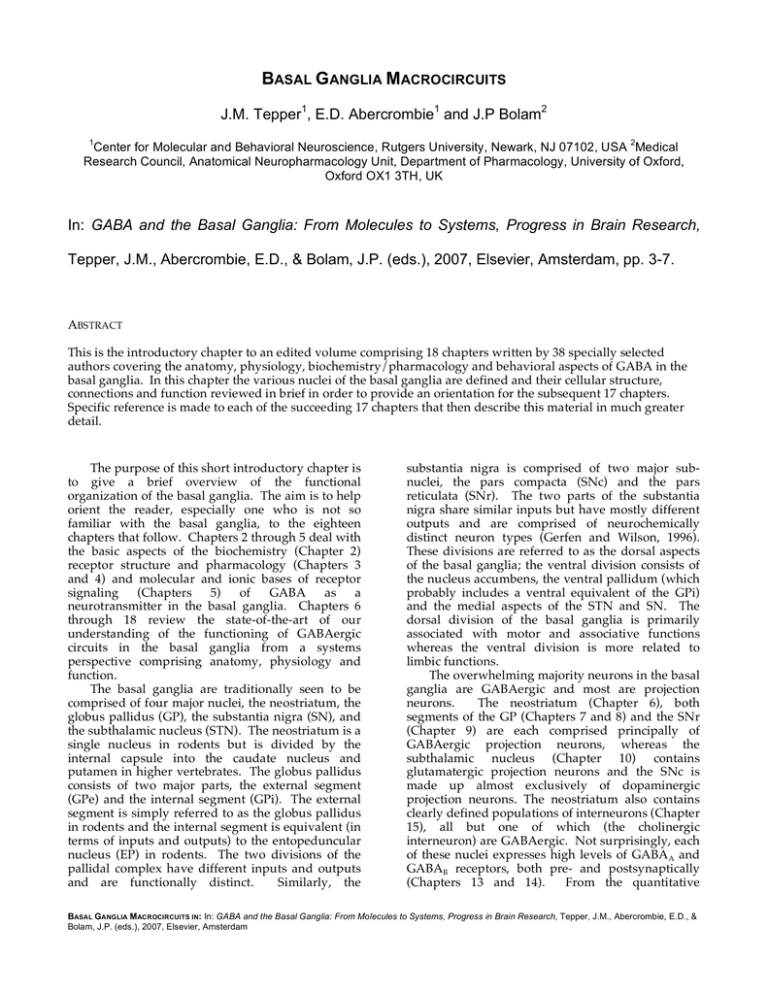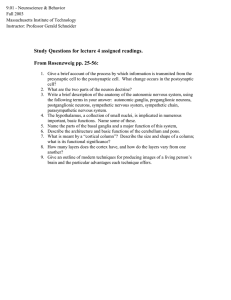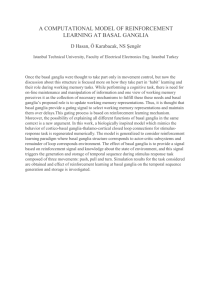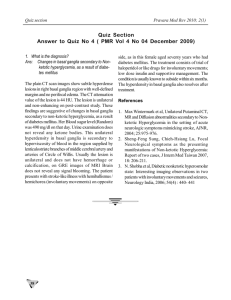J.M. Tepper1, E.D. Abercrombie1 and J.P Bolam2 In: GABA and the
advertisement

BASAL GANGLIA MACROCIRCUITS J.M. Tepper1, E.D. Abercrombie1 and J.P Bolam2 1 2 Center for Molecular and Behavioral Neuroscience, Rutgers University, Newark, NJ 07102, USA Medical Research Council, Anatomical Neuropharmacology Unit, Department of Pharmacology, University of Oxford, Oxford OX1 3TH, UK In: GABA and the Basal Ganglia: From Molecules to Systems, Progress in Brain Research, Tepper, J.M., Abercrombie, E.D., & Bolam, J.P. (eds.), 2007, Elsevier, Amsterdam, pp. 3-7. ABSTRACT This is the introductory chapter to an edited volume comprising 18 chapters written by 38 specially selected authors covering the anatomy, physiology, biochemistry/pharmacology and behavioral aspects of GABA in the basal ganglia. In this chapter the various nuclei of the basal ganglia are defined and their cellular structure, connections and function reviewed in brief in order to provide an orientation for the subsequent 17 chapters. Specific reference is made to each of the succeeding 17 chapters that then describe this material in much greater detail. The purpose of this short introductory chapter is to give a brief overview of the functional organization of the basal ganglia. The aim is to help orient the reader, especially one who is not so familiar with the basal ganglia, to the eighteen chapters that follow. Chapters 2 through 5 deal with the basic aspects of the biochemistry (Chapter 2) receptor structure and pharmacology (Chapters 3 and 4) and molecular and ionic bases of receptor signaling (Chapters 5) of GABA as a neurotransmitter in the basal ganglia. Chapters 6 through 18 review the state-of-the-art of our understanding of the functioning of GABAergic circuits in the basal ganglia from a systems perspective comprising anatomy, physiology and function. The basal ganglia are traditionally seen to be comprised of four major nuclei, the neostriatum, the globus pallidus (GP), the substantia nigra (SN), and the subthalamic nucleus (STN). The neostriatum is a single nucleus in rodents but is divided by the internal capsule into the caudate nucleus and putamen in higher vertebrates. The globus pallidus consists of two major parts, the external segment (GPe) and the internal segment (GPi). The external segment is simply referred to as the globus pallidus in rodents and the internal segment is equivalent (in terms of inputs and outputs) to the entopeduncular nucleus (EP) in rodents. The two divisions of the pallidal complex have different inputs and outputs and are functionally distinct. Similarly, the substantia nigra is comprised of two major subnuclei, the pars compacta (SNc) and the pars reticulata (SNr). The two parts of the substantia nigra share similar inputs but have mostly different outputs and are comprised of neurochemically distinct neuron types (Gerfen and Wilson, 1996). These divisions are referred to as the dorsal aspects of the basal ganglia; the ventral division consists of the nucleus accumbens, the ventral pallidum (which probably includes a ventral equivalent of the GPi) and the medial aspects of the STN and SN. The dorsal division of the basal ganglia is primarily associated with motor and associative functions whereas the ventral division is more related to limbic functions. The overwhelming majority neurons in the basal ganglia are GABAergic and most are projection neurons. The neostriatum (Chapter 6), both segments of the GP (Chapters 7 and 8) and the SNr (Chapter 9) are each comprised principally of GABAergic projection neurons, whereas the subthalamic nucleus (Chapter 10) contains glutamatergic projection neurons and the SNc is made up almost exclusively of dopaminergic projection neurons. The neostriatum also contains clearly defined populations of interneurons (Chapter 15), all but one of which (the cholinergic interneuron) are GABAergic. Not surprisingly, each of these nuclei expresses high levels of GABAA and GABAB receptors, both pre- and postsynaptically (Chapters 13 and 14). From the quantitative BASAL GANGLIA MACROCIRCUITS IN: In: GABA and the Basal Ganglia: From Molecules to Systems, Progress in Brain Research, Tepper, J.M., Abercrombie, E.D., & Bolam, J.P. (eds.), 2007, Elsevier, Amsterdam analyses of Oorschot (1996) we know that the dorsal components of the basal ganglia in rats contain a total of 2886.3 x 103 neurons but only 32.8 x 103 are not GABAergic (i.e., the neurons of the STN, SNc and the cholinergic interneurons in the neostriatum). Thus 98.86% of neurons in the basal ganglia are GABAergic. (Perhaps the title of this book should have been “GABA is the Basal Ganglia”.) The principal pathways for information flow through the basal ganglia, the macrocircuitry, is illustrated in Figure 1, which is also of course a simplification of the true state of affairs. The principal afferents of the basal ganglia arise from the cerebral cortex (both ipsi- and contralateral), the intralaminar thalamic cell nuclei (e.g. centromedian and parafascicular nucleus), the dorsal raphé nucleus and the amygdala. The densest innervation, and by far the greatest in quantitative terms, is from the cerebral cortex and thalamus, and the major recipient of these afferents is the neostriatum. Together, the cortical and thalamic inputs form about 85% of all the synapses in neostriatum. These afferents are glutamatergic, contain small round vesicles and form Gray’s Type I (asymmetric) synapses. The major target of these afferents, accounting for nearly 90% of corticostriatal synapses, are the heads of spines of the principal neurons of the neostriatum, the medium sized, densely spiny neurons (Wilson, 2004). These are GABAergic neurons, account for as much as 95% of the neurons in neostriatum in rodents (and 75-80% in primates) and are the principal projection neurons of the neostriatum, innervating the substantia nigra and pallidal complex. The spiny neurons emit a dense local axon collateral system that innervates other spiny cells and striatal interneurons (Chapter 6), influencing them in a complex way that has been subject to computational modeling (Chapter 18). Cortical and thalamic terminals also innervate the dendrites of the aspiny cholinergic interneuron and the GABAergic interneurons and in the latter neurons at least, cortical afferents may account for the majority of their afferent synapses (Bolam et al., 2000). Projections arising from discrete areas of cortex have terminal fields that extend for great distances in neostriatum particularly in the rostro-caudal plane. They tend to cross over the dendrites of the spiny neuron at right angles (“cruciform axodendritic arrangement”) with the result that each spiny neuron gets very few, at most only 1 or 2 synapses from a single corticostriatal neuron (Wilson, 2004). Similarly, thalamostriatal neurons extend their axons over wide regions of the neostriatum although the precise configuration varies with the thalamic nucleus of origin. The fact that the spiny neurons possess in the region of 15,000 spines implies that there is a massive degree of convergence of cortical and thalamic neurons at the level of individual spiny neurons in the Figure 1: Simplified diagram of the macrocircuits of the dorsal components of the basal ganglia. The nuclei of the basal ganglia are included in the light blue box and consist of the neostriatum (Striatum), the external segment of the globus pallidus (GPe), the subthalamic nucleus (STN), the substantia nigra pars reticulata and the internal segment of the globus pallidus (SNr/GPi) which together constitute the output nuclei of the basal ganglia and the substantia nigra pars compacta (SNc). The two major inputs to the basal ganglia are from the neocortex and the thalamus (mainly the intralaminar nuclei). The basal ganglia influence behavior by the output nuclei projecting to the thalamus (mainly the ventral) and thence back to the cortex, and projections to the superior colliculus (SC), the reticular formation (RF), the pedunculopontine nucleus (PPN) and the lateral habenula (HBN). Dopamine neurons of the substantia nigra pars compacta (SNc) provide a massive feedback to the neostriatum and also the GPe and STN which modulates the flow of cortical and thalamic information through the basal ganglia. Dark blue indicates structures that are principally GABAergic; red indicates structures that are principally glutamatergic, yellow indicates structures that are dopaminergic and green indicates structures with variable neurochemistry. neostriatum. The other major input to the neostriatum, that from the substantia nigra pars compacta, is dopaminergic, and forms symmetric synapses with dendritic shafts or necks of spines of the spiny projection neurons, and, to a lesser extent, with other neostriatal cell types including the giant aspiny cholinergic neuron. Dopamine acts principally as a neuromodulator in neostriatum to powerfully modulate voltage-gated sodium and calcium channels in medium spiny neurons and cholinergic interneurons. This modulation leads directly to complex and state-dependent changes in neostriatal neuronal excitability (Surmeier, 2006). Dopamine also acts to modulate GABA release in the substantia nigra presynaptically (Chapter 14). For the last 20 years or so, the macrocircuitry of the basal ganglia has been considered to be dominated by two principal pathways by which neocortical information is transmitted to the output nuclei of the basal ganglia, the SNr and GPi (Smith et al., 1998). The so-called direct pathway is BASAL GANGLIA MACROCIRCUITS IN: In: GABA and the Basal Ganglia: From Molecules to Systems, Progress in Brain Research, Tepper, J.M., Abercrombie, E.D., & Bolam, J.P. (eds.), 2007, Elsevier, Amsterdam comprised of neostriatal GABAergic neurons that project directly to the SNr and GPi where they make direct synaptic contact with the GABAergic output neurons. Neurons giving rise to the direct pathway also give rise to collaterals to the GPe (Kawaguchi et al 1990). The indirect pathway comprises neostriatal GABAergic neurons that project almost exclusively to the GABAergic neurons of the GPe. These neurons in turn innervate the GABAergic output neurons in the SNr/GPi and also do so indirectly by innervating the glutamatergic neurons of the STN that then innervate the GABAergic output neurons in the SNr/GPi. The neostriatal neurons giving rise to the direct and indirect pathways have very similar electrophysiological and morphological properties, but they have distinguishing neurochemical features: the direct pathway neurons express the dopamine D1 receptor and substance P and dynorphin whereas the indirect pathway neurons express the dopamine D2 receptor and enkephalin (Chapter 16). There is also a small proportion of neurons that expresses both sets of markers (Surmeier, 2006). The GABAergic neurons of the GPe are in a unique position in that their extensive axon collaterals enable them to influence activity at every level of the basal ganglia (Chapter 7). Data from single-cell labelling studies (Kita and Kitai, 1994; Bevan et al., 1998; Sato et al., 2000) have demonstrated that all GPe projection neurons give rise to local axon collaterals and innervate the STN nucleus, the basal ganglia output nuclei and probably also the SNc. In each of these regions they make synapses with the cell bodies and proximal dendrites of their target neurons. In addition, about one quarter to one third of GPe neuron also innervate the neostriatum (Kita and Kitai, 1994; Bevan et al., 1998) where they are in a position to influence the activity of all neostriatal neurons by selectively innervating GABAergic interneurons (Bevan et al., 1998) which, in turn, innervate the spiny projection neurons (Kita, 1993; Bennett et al., 1994; Koos and Tepper, 1999). Thus the role of GPe neurons is not to simply to invert and transmit neostriatal information to the STN or basal ganglia output nuclei but rather, they are in a position to provide some sort of spatiotemporal selection of neurons at every level of the basal ganglia. The second major port of entry of neocortical and thalamic information into the basal ganglia is the STN. This nucleus receives dense excitatory inputs from the motor and dorsal prefrontal cortices and the intralaminar thalamic nuclei. By virtue of the STN projection to the SNr/GPi, the corticosubthalamic pathway (and probably the thalamosubthalamic pathway) is the fastest route by which cortical information (and thalamic) can influence activity in the output nuclei, and has been referred to as the hyperdirect pathway (Kita, 1994). This pathway can be considered as a critical driving force in the basal ganglia output nuclei and in the GPe. The output nuclei of the basal ganglia, the SNr and the GPi, are also comprised essentially entirely of GABAergic projection neurons. These neurons project principally to the ventral tier of the dorsal thalamus and/or to the tectum where they exert powerful inhibition on their thalamic and tectal targets (Chapter 12). Many or most of the SNr/GPi neurons also co-express parvalbumin, calretinin or calbindin, but as in the neostriatum these neurochemically heterogenous neurons exhibit very similar morphological and physiological properties. The SNr neurons also emit local axon collaterals that innervate the dopaminergic neurons of the SNc, thereby providing an important regulatory input to the nigrostriatal dopamine system (Tepper et al., 2002; Chapter 11). It is thus evident that although the principal driving force of the basal ganglia i.e. that derived from the cortex and thalamus, is glutamatergic, the majority of principal neurons in each division of the basal ganglia are GABAergic. Furthermore, every neuron in the basal ganglia is regulated by GABAergic inputs from multiple sources. The basal ganglia can thus be seen as a series or chain of GABAergic neurons that is regulated to a large extent by GABAergic inputs and that ultimately provide a GABAergic output to the basal ganglia targets. Through these circuits the basal ganglia exert powerful control over voluntary movements, and disease and/or damage to the basal ganglia result in well-defined movement disorders (Chapter 17). There is also a growing appreciation for the role of the basal ganglia in non-motor, higher order cognitive functions such as learning (Graybiel, 2005). In a larger sense it has been argued that the basal ganglia is part of a loop that supports thalamocortical interactions and thus cortical function by positive feedback (Wilson, 2004). Regardless of how one chooses to describe the basal ganglia’s function, it is critical for our understanding of the basal ganglia to understand the organization, connectivity and properties of GABAergic neurons in each component of the system. ACKNOWLEDGEMENTS: Supported in part by Supported by a grant from the National Institute for Neurological Diseases and Stroke (NS-34865), U.S.A. (JMT) and the Medical Research Council, U.K (JPB). Many thanks to Ben Micklem for the preparation of the figure. BASAL GANGLIA MACROCIRCUITS IN: In: GABA and the Basal Ganglia: From Molecules to Systems, Progress in Brain Research, Tepper, J.M., Abercrombie, E.D., & Bolam, J.P. (eds.), 2007, Elsevier, Amsterdam REFERENCES Bennett BD, Bolam JP (1994) Synaptic input and output of parvalbumin-immunoreactive neurons in the neostriatum of the rat. Neuroscience 62,3:707-719. Bevan MD, Booth PAC, Eaton SA, Bolam JP (1998) Selective innervation of neostriatal interneurons by a subclass of neuron in the globus pallidus of the rat. J Neurosci.18:9438-9452. Bolam JP, Hanley JJ, Booth PA, Bevan MD (2000) Synaptic organisation of the basal ganglia. J Anat 196 (Pt 4):527-542. Gerfen, CR, Wilson, CJ (1996) The basal ganglia. In: Handbook of Chemical Neuroanatomy, Vol. 12: Integrated Systems of the CNS, Part III (L.W. Swanson, A. Bjorklund, T Hökfelt, eds) Elsevier Science BV, Amsterdam, pp 371-468. Graybiel AM (2005) The basal ganglia: learning new tricks and loving it. Curr Opin Neurobiol 15:638644. Kawaguchi Y, Wilson CJ, Emson PC (1990) Projection subtypes of rat neostriatal matrix cells revealed by intracellular injection of biocytin. Journal of Neuroscience 10,10:3421-3438. Kita H (1993) GABAergic circuits of the striatum. Prog Brain Res 99:51-72. Kita H (1994) Physiology of two disynaptic pathways from the sensorimotor cortex to the basal ganglia output nuclei. In: The Basal Ganglia IV Adv. Behav. Biol. Vol. 41 (Percheron G, Ed), Plenum Press, New York, pp 263-276.. Kita H, Kitai ST (1994) The morphology of globus pallidus projection neurons in the rat: an intracellular staining study. Brain Research 636:308-319. Koos T, Tepper JM (1999) Inhibitory control of neostriatal projection neurons by GABAergic interneurons. Nat Neurosc 2:467-472. Oorschot DE (1996) Total number of neurons in the neostriatal, pallidal, subthalamic, and substantia nigral nuclei of the rat basal ganglia: A stereological study using the cavalieri and optical disector methods. J Comp Neurol 366:580-599. Sato F, Lavallee P, Levesque M, Parent A (2000) Single-axon tracing study of neurons of the external segment of the globus pallidus in primate. J Comp Neurol 417:17-31. Smith Y, Bevan MD, Shink E, Bolam JP (1998) Microcircuitry of the direct and indirect pathways of the basal ganglia. Neuroscience 86:353-387. Surmeier, D.J, (2006) Microcircuits in the striatum: Cell types, intrinsic properties and Neuromodulation, In Microcircuits - The Interface Between Neurons and Global Brain Function (S Grillner, AM Graybiel, Eds), MIT Press, Cambridge, pp 105-12. Tepper JM, Celada P, Iribe Y, Paladini, CA (2002) Afferent control of nigral dopaminergic neurons The role of GABAergic inputs. In: The Basal Ganglia VI, Adv. Behav. Biol. Vol. 54 (A.M. Graybiel, M.R. DeLong & S.T. Kitai Eds.), Kluwer Academic Publishers, Norwell, pp 641-651. Wilson, CJ (2004) The basal ganglia. In: The Synaptic Organization of the Brain (GM Shepherd, Ed.), Oxford University Press, Oxford, pp 361-414. BASAL GANGLIA MACROCIRCUITS IN: In: GABA and the Basal Ganglia: From Molecules to Systems, Progress in Brain Research, Tepper, J.M., Abercrombie, E.D., & Bolam, J.P. (eds.), 2007, Elsevier, Amsterdam





